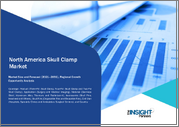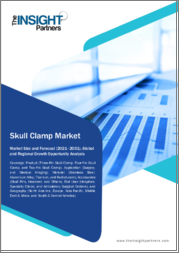
|
시장보고서
상품코드
1589198
세계의 두개 클램프 시장 : 환자별, 용도별, 최종 사용자별 예측(2025-2030년)Cranial Clamps Market by Patient (Adult, Pediatric), Application (Imaging, Surgery), End-User - Global Forecast 2025-2030 |
||||||
두개 클램프 시장은 2023년에 2억 9,014만 달러로 평가되고, 2024년에는 3억 990만 달러에 달할 것으로 예측되며, 복합 연간 성장률(CAGR) 6.90%로 성장하여, 2030년에는 4억 6,302만 달러에 이를 것으로 예측됩니다.
두개 클램프는 뇌 신경 수술 및 신경 영상 진단에 필수적이며 환자의 머리를 고정하고 정확성과 안정성을 제공하도록 설계된 장치입니다. 이러한 클램프는 정확한 수술과 영상 진단을 용이하게 하여 결과에 영향을 미칠 수 있는 불필요한 움직임을 방지하는 중요한 역할을 합니다. 개두 수술, 뇌 생검, 두개내 장치 설치 등 다양한 뇌신경 수술에 사용됨으로써 두개 클램프의 필요성이 강조되고 있습니다. 최종 용도로는 병원, 외래수술센터(ASC), 전문 클리닉이 포함되며, 신경 질환의 유병률 상승과 수술 수요 증가가 배경에 있습니다. 두개 클램프 시장에 영향을 미치는 주요 성장 요인으로는 의료 기술의 진보, 건강 관리 지출 증가, 세계 수술 건수 증가 등이 있습니다. 뇌 건강에 대한 의식이 높아지고 건강 관리 인프라에 대한 투자가 증가하면 특히 신흥국 시장에서 유망한 기회가 생깁니다. 기업은 제품 혁신에 중점을 두고 사용자 친화적인 설계에 중점을 두고 엄격한 안전 표준을 철저히 준수함으로써 이러한 성장 요인을 활용할 수 있습니다. 하지만 고도의 두개 클램프와 관련된 고비용, 한정적인 상환 정책, 이러한 장비를 조작하기 위한 첨단 기술을 가진 전문가의 필요성 등의 과제에 시장의 성장은 직면하고 있습니다. 또한 치열한 경쟁과 규제 장애물이 장벽이 될 수 있습니다. 기술 혁신과 사업성장을 위해 기업은 일회용 클램프와 저침습성 클램프 개발, 로봇 지원 수술 시스템과의 통합, 보다 우수한 환자의 쾌적성과 안전성을 제공하는 소재 등의 분야를 모색할 것 수 있습니다. 또한 인체 공학적 설계와 다양한 환자층에 적응하는 클램프의 지속적인 연구가 좋은 결과를 초래할 수 있습니다. 획득하기 위해 연구 개발과 전략적 파트너십에 중점을 두어야 합니다. 전반적으로 이 분야의 성공은 기술적 진보와 비용 효과의 균형을 맞추고 다양한 건강 관리 환경에서 제품에 대한 액세스를 넓힐 수 있습니다. 필요합니다.
| 주요 시장 통계 | |
|---|---|
| 기준년(2023) | 2억 9,014만 달러 |
| 예측년(2024) | 3억990만 달러 |
| 예측년(2030) | 4억 6,302만 달러 |
| 복합 연간 성장률(CAGR)(%) | 6.90% |
시장 역학 : 빠르게 진화하는 두개 클램프 시장의 주요 시장 인사이트 공개
두개골 클램프 시장은 수요 및 공급의 역동적인 상호 작용에 의해 변모를 이루고 있습니다. 그리고 새로운 비즈니스 기회 획득에 대비 할 수 있습니다. 이러한 동향을 종합적으로 파악함으로써 기업은 정치적, 지리적, 기술적, 사회적, 경제적 영역에 걸친 다양한 리스크를 경감할 수 있음과 동시에 소비자 행동과 그것이 제조 비용과 구매 동향에 미치는 영향을 보다 명확하게 이해할 수 있습니다.
- 시장 성장 촉진요인
- 신경 질환 증가
- 교통사고나 전도에 의한 부상 증가
- 유리한 상환 정책에 따른 건강 관리 인프라 증가
- 시장 성장 억제요인
- 수술에 따른 고비용
- 시장 기회
- 두개 클램프와 관련된 지속적인 기술 발전
- 저침습 수술의 큰 성장
- 시장의 과제
- 숙련된 헬스케어 전문가의 부족
Porter's Five Forces : 두개 클램프 시장을 탐색하는 전략 도구
Porter's Five Forces Framework는 시장 상황경쟁 구도를 이해하는 중요한 도구입니다. Porter's Five Forces Framework는 기업의 경쟁을 평가하고 전략적 기회를 탐구하는 명확한 기술을 설명합니다. 이 프레임워크는 기업이 시장 내 세력도를 평가하고 신규 사업의 수익성을 결정하는 데 도움이 됩니다. 수있는 더 강인한 시장에서 포지셔닝을 보장 할 수 있습니다.
PESTLE 분석 : 두개 클램프 시장에서 외부로부터의 영향 파악
외부 거시 환경 요인은 두개골 클램프 시장의 성과 역학을 형성하는데 매우 중요한 역할을 합니다. 정치적, 경제적, 사회적, 기술적, 법적, 환경적 요인 분석은 이러한 영향을 탐색하는 데 필요한 정보를 제공합니다. PESTLE 요인을 조사함으로써 기업은 잠재적인 위험과 기회를 더 잘 이해할 수 있습니다. 이 분석을 통해 기업은 규제, 소비자 선호, 경제 동향의 변화를 예측하고 앞으로 예상되는 적극적인 의사 결정을 할 준비가 가능합니다.
시장 점유율 분석 두개골 클램프 시장에서 경쟁 구도 파악
두개 클램프 시장의 상세한 시장 점유율 분석을 통해 공급업체의 성과를 종합적으로 평가할 수 있습니다. 기업은 수익, 고객 기반, 성장률 등 주요 지표를 비교하여 경쟁 포지셔닝을 밝힐 수 있습니다. 이 분석을 통해 시장 집중, 단편화 및 통합 동향을 밝혀내고 공급업체는 경쟁이 치열해지면서 자신의 입지를 높이는 전략적 의사 결정을 내리는 데 필요한 지식을 얻을 수 있습니다.
FPNV 포지셔닝 매트릭스 두개 클램프 시장에서 공급업체의 성능 평가
FPNV 포지셔닝 매트릭스는 두개골 클램프 시장에서 공급업체를 평가하는 중요한 도구입니다. 이 행렬을 통해 비즈니스 조직은 공급업체의 비즈니스 전략과 제품 만족도를 기준으로 평가하여 목표에 맞는 충분한 정보를 바탕으로 의사 결정을 내릴 수 있습니다. 네 가지 사분면을 통해 공급업체를 명확하고 정확하게 부문화하고 전략 목표에 가장 적합한 파트너 및 솔루션을 파악할 수 있습니다.
전략 분석 및 추천 두개 클램프 시장에서 성공을 위한 길을 그리기
두개 클램프 시장의 전략 분석은 시장에서의 존재를 강화하려는 기업에 필수적입니다. 주요 자원, 능력 및 성과 지표를 검토함으로써 기업은 성장 기회를 파악하고 개선을 위해 노력할 수 있습니다. 이러한 접근 방식을 통해 경쟁 구도에서 과제를 극복하고 새로운 비즈니스 기회를 활용하여 장기적인 성공을 거둘 수 있는 체제를 구축할 수 있습니다.
이 보고서는 주요 관심 분야를 포괄하는 시장의 종합적인 분석을 제공합니다.
1. 시장 침투 : 현재 시장 환경의 상세한 검토, 주요 기업의 광범위한 데이터, 시장 도달범위 및 전반적인 영향력 평가.
2. 시장 개척도 : 신흥 시장의 성장 기회를 파악하고 기존 분야의 확장 가능성을 평가하며 미래 성장을 위한 전략적 로드맵을 제공합니다.
3. 시장 다양화 : 최근 제품 출시, 미개척 지역, 업계의 주요 진보, 시장을 형성하는 전략적 투자를 분석합니다.
4. 경쟁 평가 및 정보 : 경쟁 구도를 철저히 분석하여 시장 점유율, 사업 전략, 제품 포트폴리오, 인증, 규제 당국 승인, 특허 동향, 주요 기업의 기술 진보 등을 검증합니다.
5. 제품 개발 및 혁신 : 미래 시장 성장을 가속할 것으로 예상되는 최첨단 기술, R&D 활동, 제품 혁신을 강조합니다.
또한 이해관계자가 충분한 정보를 얻고 의사결정을 할 수 있도록 중요한 질문에 대답하고 있습니다.
1. 현재 시장 규모와 향후 성장 예측은?
2. 최고의 투자 기회를 제공하는 제품, 부문 및 지역은 어디입니까?
3. 시장을 형성하는 주요 기술 동향과 규제의 영향은?
4. 주요 벤더의 시장 점유율과 경쟁 포지션은?
5. 벤더 시장 진입, 철수 전략의 원동력이 되는 수익원과 전략적 기회는 무엇인가?
목차
제1장 서문
제2장 조사 방법
제3장 주요 요약
제4장 시장 개요
제5장 시장 인사이트
- 시장 역학
- 성장 촉진요인
- 신경질환의 발생률 증가
- 교통사고나 전도에 의한 상해의 발생률의 상승
- 헬스케어 인프라의 강화와 유리한 상환 정책
- 억제요인
- 수술에 따른 고액의 비용
- 기회
- 두개 클램프와 관련된 지속적인 기술 발전
- 저침습 수술의 대폭적인 증가
- 과제
- 숙련된 헬스케어 종사자의 부족
- 성장 촉진요인
- 시장 세분화 분석
- Porter's Five Forces 분석
- PESTEL 분석
- 정치적
- 경제
- 사교
- 기술적
- 법률상
- 환경
제6장 두개 클램프 시장 : 환자별
- 성인용
- 소아과
제7장 두개 클램프 시장 : 용도별
- 영상
- 수술
제8장 두개 클램프 시장 : 최종 사용자별
- 외래수술센터(ASC)
- 클리닉
- 병원
제9장 아메리카 두개 클램프 시장
- 아르헨티나
- 브라질
- 캐나다
- 멕시코
- 미국
제10장 아시아태평양의 두개 클램프 시장
- 호주
- 중국
- 인도
- 인도네시아
- 일본
- 말레이시아
- 필리핀
- 싱가포르
- 한국
- 대만
- 태국
- 베트남
제11장 유럽, 중동 및 아프리카의 두개 클램프 시장
- 덴마크
- 이집트
- 핀란드
- 프랑스
- 독일
- 이스라엘
- 이탈리아
- 네덜란드
- 나이지리아
- 노르웨이
- 폴란드
- 카타르
- 러시아
- 사우디아라비아
- 남아프리카
- 스페인
- 스웨덴
- 스위스
- 터키
- 아랍에미리트(UAE)
- 영국
제12장 경쟁 구도
- 시장 점유율 분석(2023년)
- FPNV 포지셔닝 매트릭스(2023년)
- 경쟁 시나리오 분석
- 전략 분석과 제안
기업 목록
- B. Braun Melsungen AG
- Bahadir Medical Devices
- Changzhou Huida Medical Instrument Co. Ltd.
- evonos GmbH & Co. KG
- IMRIS, Deerfield Imaging, Inc.
- INSPITAL MEDICAL TECHNOLOGY GmbH
- Integra Lifesciences Corporation
- JEIL MEDICAL CORPORATION
- Johnson & Johnson Services, Inc.
- medical bees GmbH
- Medifa
- Micromar Ind E.com
- Ningbo Techart Medical Equipment Co.Ltd.
- Pro Med Instruments GmbH
- VITALYS SURGICAL
The Cranial Clamps Market was valued at USD 290.14 million in 2023, expected to reach USD 309.90 million in 2024, and is projected to grow at a CAGR of 6.90%, to USD 463.02 million by 2030.
Cranial clamps, essential in neurosurgery and neuroimaging, are devices designed to immobilize the patient's head, providing precision and stability. These clamps play a crucial role in facilitating accurate surgical procedures and diagnostic imaging, thereby preventing unnecessary movements that could affect the outcomes. The necessity of cranial clamps is underscored by their application in various neurosurgical procedures such as craniotomies, brain biopsies, and the placement of intracranial devices. End-use includes hospitals, ambulatory surgical centers, and specialty clinics, driven by the rising prevalence of neurological disorders and increased surgical demand. Key growth factors influencing the cranial clamps market include advancements in medical technology, increasing healthcare expenditure, and the growing number of surgeries globally. Enhanced awareness about brain health and increasing investments in healthcare infrastructure present promising opportunities, especially in developing markets. Companies can leverage these growth factors by emphasizing product innovation, focusing on user-friendly designs, and ensuring compliance with stringent safety standards. Nonetheless, market growth faces challenges from high costs associated with advanced cranial clamps, limited reimbursement policies, and the need for highly skilled professionals to operate such devices. Additionally, intense competition and regulatory hurdles could act as barriers. For innovation and business growth, companies can explore areas such as the development of disposable or minimally-invasive clamps, integration with robotic-assisted surgery systems, and materials offering better patient comfort and safety. Furthermore, continuous research into ergonomic designs and clamp adaptability for different patient demographics could yield favorable results. The nature of the market is increasingly competitive, necessitating a strong focus on research and development and strategic partnerships to drive differentiation and capture market share. Overall, success in this field requires balancing technological advancements with cost-effectiveness and broadening product accessibility across varied healthcare settings.
| KEY MARKET STATISTICS | |
|---|---|
| Base Year [2023] | USD 290.14 million |
| Estimated Year [2024] | USD 309.90 million |
| Forecast Year [2030] | USD 463.02 million |
| CAGR (%) | 6.90% |
Market Dynamics: Unveiling Key Market Insights in the Rapidly Evolving Cranial Clamps Market
The Cranial Clamps Market is undergoing transformative changes driven by a dynamic interplay of supply and demand factors. Understanding these evolving market dynamics prepares business organizations to make informed investment decisions, refine strategic decisions, and seize new opportunities. By gaining a comprehensive view of these trends, business organizations can mitigate various risks across political, geographic, technical, social, and economic domains while also gaining a clearer understanding of consumer behavior and its impact on manufacturing costs and purchasing trends.
- Market Drivers
- Increasing incidences of neurological diseases
- Rise in the incidence of road accidents and fall injuries
- Rising healthcare infrastructure along with favorable reimbursement policies
- Market Restraints
- High cost associated with surgeries
- Market Opportunities
- Continuous technological advancements associated with cranial clamps
- Massive growth in minimally invasive surgeries
- Market Challenges
- Shortage of skilled healthcare professionals
Porter's Five Forces: A Strategic Tool for Navigating the Cranial Clamps Market
Porter's five forces framework is a critical tool for understanding the competitive landscape of the Cranial Clamps Market. It offers business organizations with a clear methodology for evaluating their competitive positioning and exploring strategic opportunities. This framework helps businesses assess the power dynamics within the market and determine the profitability of new ventures. With these insights, business organizations can leverage their strengths, address weaknesses, and avoid potential challenges, ensuring a more resilient market positioning.
PESTLE Analysis: Navigating External Influences in the Cranial Clamps Market
External macro-environmental factors play a pivotal role in shaping the performance dynamics of the Cranial Clamps Market. Political, Economic, Social, Technological, Legal, and Environmental factors analysis provides the necessary information to navigate these influences. By examining PESTLE factors, businesses can better understand potential risks and opportunities. This analysis enables business organizations to anticipate changes in regulations, consumer preferences, and economic trends, ensuring they are prepared to make proactive, forward-thinking decisions.
Market Share Analysis: Understanding the Competitive Landscape in the Cranial Clamps Market
A detailed market share analysis in the Cranial Clamps Market provides a comprehensive assessment of vendors' performance. Companies can identify their competitive positioning by comparing key metrics, including revenue, customer base, and growth rates. This analysis highlights market concentration, fragmentation, and trends in consolidation, offering vendors the insights required to make strategic decisions that enhance their position in an increasingly competitive landscape.
FPNV Positioning Matrix: Evaluating Vendors' Performance in the Cranial Clamps Market
The Forefront, Pathfinder, Niche, Vital (FPNV) Positioning Matrix is a critical tool for evaluating vendors within the Cranial Clamps Market. This matrix enables business organizations to make well-informed decisions that align with their goals by assessing vendors based on their business strategy and product satisfaction. The four quadrants provide a clear and precise segmentation of vendors, helping users identify the right partners and solutions that best fit their strategic objectives.
Strategy Analysis & Recommendation: Charting a Path to Success in the Cranial Clamps Market
A strategic analysis of the Cranial Clamps Market is essential for businesses looking to strengthen their global market presence. By reviewing key resources, capabilities, and performance indicators, business organizations can identify growth opportunities and work toward improvement. This approach helps businesses navigate challenges in the competitive landscape and ensures they are well-positioned to capitalize on newer opportunities and drive long-term success.
Key Company Profiles
The report delves into recent significant developments in the Cranial Clamps Market, highlighting leading vendors and their innovative profiles. These include B. Braun Melsungen AG, Bahadir Medical Devices, Changzhou Huida Medical Instrument Co., Ltd., evonos GmbH & Co. KG, IMRIS, Deerfield Imaging, Inc., INSPITAL MEDICAL TECHNOLOGY GmbH, Integra Lifesciences Corporation, JEIL MEDICAL CORPORATION, Johnson & Johnson Services, Inc., medical bees GmbH, Medifa, Micromar Ind E.com, Ningbo Techart Medical Equipment Co.,Ltd., Pro Med Instruments GmbH, and VITALYS SURGICAL.
Market Segmentation & Coverage
This research report categorizes the Cranial Clamps Market to forecast the revenues and analyze trends in each of the following sub-markets:
- Based on Patient, market is studied across Adult and Pediatric.
- Based on Application, market is studied across Imaging and Surgery.
- Based on End-User, market is studied across Ambulatory Surgical Centers, Clinics, and Hospitals.
- Based on Region, market is studied across Americas, Asia-Pacific, and Europe, Middle East & Africa. The Americas is further studied across Argentina, Brazil, Canada, Mexico, and United States. The United States is further studied across California, Florida, Illinois, New York, Ohio, Pennsylvania, and Texas. The Asia-Pacific is further studied across Australia, China, India, Indonesia, Japan, Malaysia, Philippines, Singapore, South Korea, Taiwan, Thailand, and Vietnam. The Europe, Middle East & Africa is further studied across Denmark, Egypt, Finland, France, Germany, Israel, Italy, Netherlands, Nigeria, Norway, Poland, Qatar, Russia, Saudi Arabia, South Africa, Spain, Sweden, Switzerland, Turkey, United Arab Emirates, and United Kingdom.
The report offers a comprehensive analysis of the market, covering key focus areas:
1. Market Penetration: A detailed review of the current market environment, including extensive data from top industry players, evaluating their market reach and overall influence.
2. Market Development: Identifies growth opportunities in emerging markets and assesses expansion potential in established sectors, providing a strategic roadmap for future growth.
3. Market Diversification: Analyzes recent product launches, untapped geographic regions, major industry advancements, and strategic investments reshaping the market.
4. Competitive Assessment & Intelligence: Provides a thorough analysis of the competitive landscape, examining market share, business strategies, product portfolios, certifications, regulatory approvals, patent trends, and technological advancements of key players.
5. Product Development & Innovation: Highlights cutting-edge technologies, R&D activities, and product innovations expected to drive future market growth.
The report also answers critical questions to aid stakeholders in making informed decisions:
1. What is the current market size, and what is the forecasted growth?
2. Which products, segments, and regions offer the best investment opportunities?
3. What are the key technology trends and regulatory influences shaping the market?
4. How do leading vendors rank in terms of market share and competitive positioning?
5. What revenue sources and strategic opportunities drive vendors' market entry or exit strategies?
Table of Contents
1. Preface
- 1.1. Objectives of the Study
- 1.2. Market Segmentation & Coverage
- 1.3. Years Considered for the Study
- 1.4. Currency & Pricing
- 1.5. Language
- 1.6. Stakeholders
2. Research Methodology
- 2.1. Define: Research Objective
- 2.2. Determine: Research Design
- 2.3. Prepare: Research Instrument
- 2.4. Collect: Data Source
- 2.5. Analyze: Data Interpretation
- 2.6. Formulate: Data Verification
- 2.7. Publish: Research Report
- 2.8. Repeat: Report Update
3. Executive Summary
4. Market Overview
5. Market Insights
- 5.1. Market Dynamics
- 5.1.1. Drivers
- 5.1.1.1. Increasing incidences of neurological diseases
- 5.1.1.2. Rise in the incidence of road accidents and fall injuries
- 5.1.1.3. Rising healthcare infrastructure along with favorable reimbursement policies
- 5.1.2. Restraints
- 5.1.2.1. High cost associated with surgeries
- 5.1.3. Opportunities
- 5.1.3.1. Continuous technological advancements associated with cranial clamps
- 5.1.3.2. Massive growth in minimally invasive surgeries
- 5.1.4. Challenges
- 5.1.4.1. Shortage of skilled healthcare professionals
- 5.1.1. Drivers
- 5.2. Market Segmentation Analysis
- 5.3. Porter's Five Forces Analysis
- 5.3.1. Threat of New Entrants
- 5.3.2. Threat of Substitutes
- 5.3.3. Bargaining Power of Customers
- 5.3.4. Bargaining Power of Suppliers
- 5.3.5. Industry Rivalry
- 5.4. PESTLE Analysis
- 5.4.1. Political
- 5.4.2. Economic
- 5.4.3. Social
- 5.4.4. Technological
- 5.4.5. Legal
- 5.4.6. Environmental
6. Cranial Clamps Market, by Patient
- 6.1. Introduction
- 6.2. Adult
- 6.3. Pediatric
7. Cranial Clamps Market, by Application
- 7.1. Introduction
- 7.2. Imaging
- 7.3. Surgery
8. Cranial Clamps Market, by End-User
- 8.1. Introduction
- 8.2. Ambulatory Surgical Centers
- 8.3. Clinics
- 8.4. Hospitals
9. Americas Cranial Clamps Market
- 9.1. Introduction
- 9.2. Argentina
- 9.3. Brazil
- 9.4. Canada
- 9.5. Mexico
- 9.6. United States
10. Asia-Pacific Cranial Clamps Market
- 10.1. Introduction
- 10.2. Australia
- 10.3. China
- 10.4. India
- 10.5. Indonesia
- 10.6. Japan
- 10.7. Malaysia
- 10.8. Philippines
- 10.9. Singapore
- 10.10. South Korea
- 10.11. Taiwan
- 10.12. Thailand
- 10.13. Vietnam
11. Europe, Middle East & Africa Cranial Clamps Market
- 11.1. Introduction
- 11.2. Denmark
- 11.3. Egypt
- 11.4. Finland
- 11.5. France
- 11.6. Germany
- 11.7. Israel
- 11.8. Italy
- 11.9. Netherlands
- 11.10. Nigeria
- 11.11. Norway
- 11.12. Poland
- 11.13. Qatar
- 11.14. Russia
- 11.15. Saudi Arabia
- 11.16. South Africa
- 11.17. Spain
- 11.18. Sweden
- 11.19. Switzerland
- 11.20. Turkey
- 11.21. United Arab Emirates
- 11.22. United Kingdom
12. Competitive Landscape
- 12.1. Market Share Analysis, 2023
- 12.2. FPNV Positioning Matrix, 2023
- 12.3. Competitive Scenario Analysis
- 12.4. Strategy Analysis & Recommendation
Companies Mentioned
- 1. B. Braun Melsungen AG
- 2. Bahadir Medical Devices
- 3. Changzhou Huida Medical Instrument Co., Ltd.
- 4. evonos GmbH & Co. KG
- 5. IMRIS, Deerfield Imaging, Inc.
- 6. INSPITAL MEDICAL TECHNOLOGY GmbH
- 7. Integra Lifesciences Corporation
- 8. JEIL MEDICAL CORPORATION
- 9. Johnson & Johnson Services, Inc.
- 10. medical bees GmbH
- 11. Medifa
- 12. Micromar Ind E.com
- 13. Ningbo Techart Medical Equipment Co.,Ltd.
- 14. Pro Med Instruments GmbH
- 15. VITALYS SURGICAL

















